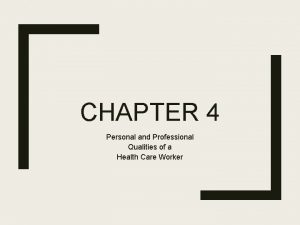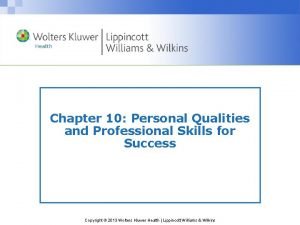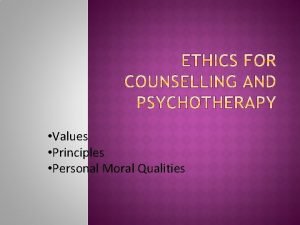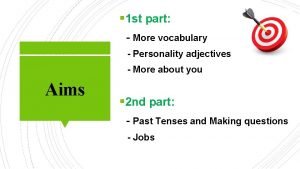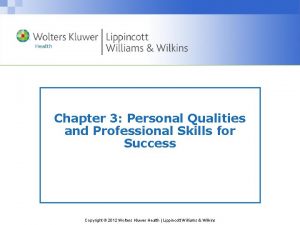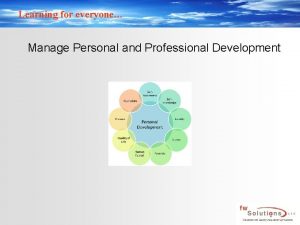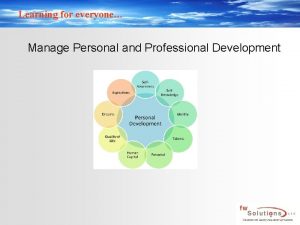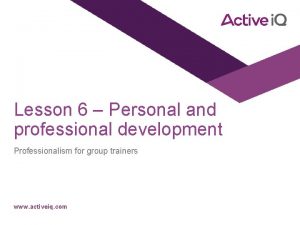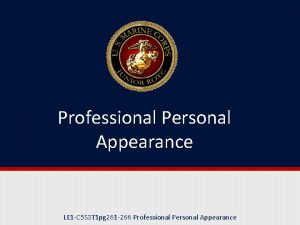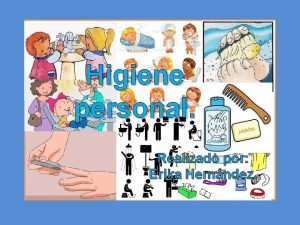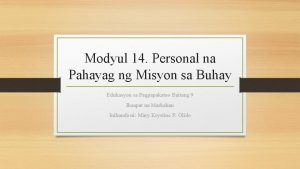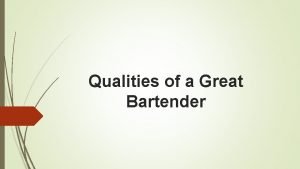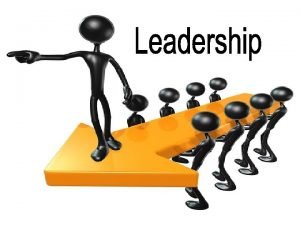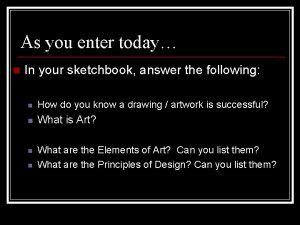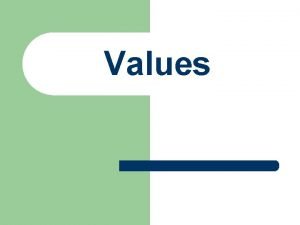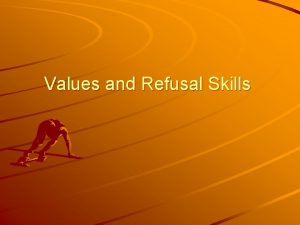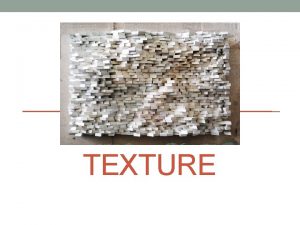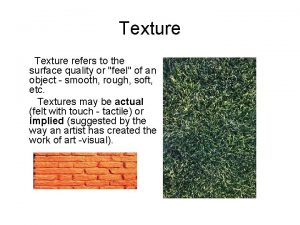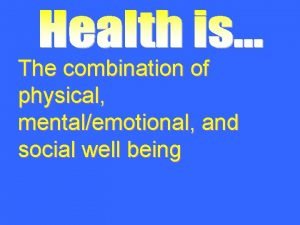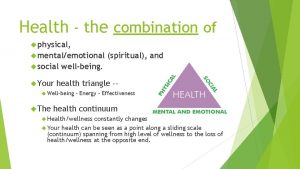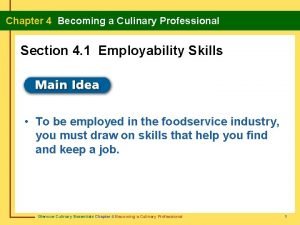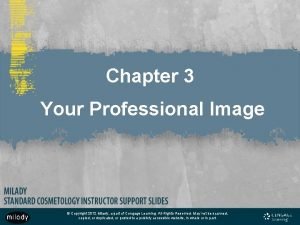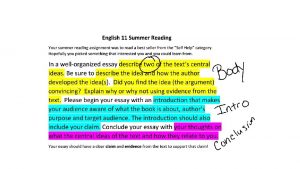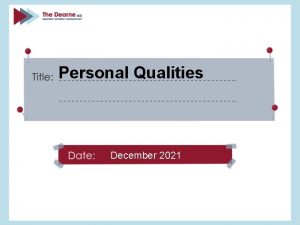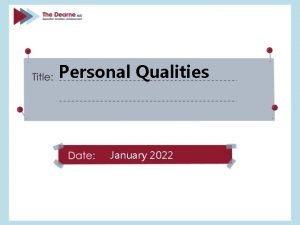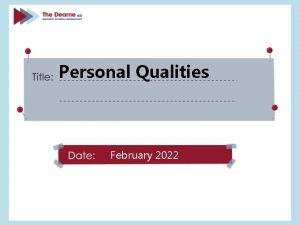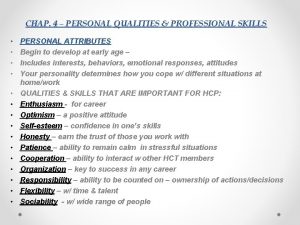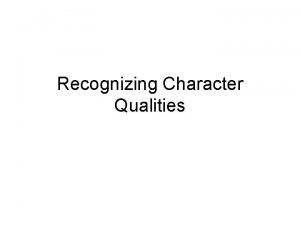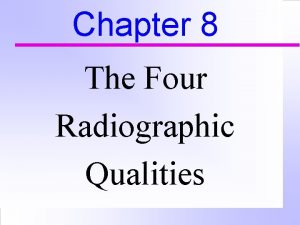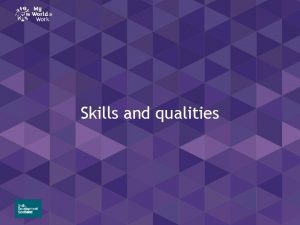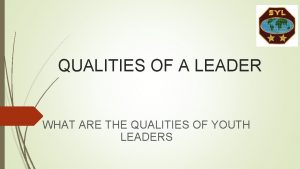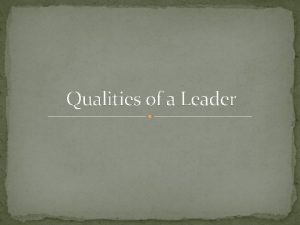CHAPTER 4 Personal and Professional Qualities of a












































- Slides: 44

CHAPTER 4 Personal and Professional Qualities of a Health Care Worker

4: 1 Personal Appearance ■ Appearance communicates level of confidence and positive self-esteem ■ First impressions are based on appearances and form quickly ■ Rules about appearance may vary ■ Certain professional standards apply to most health careers

Good Health ■ Health care involves promoting health and preventing disease ■ Health care workers serve as role models ■ Diet – – Eating well-balanced meals & nutritious foods promotes optimal health – Food Pyramid (variety – food groups) ■ Rest – See chart on next page ■ Exercise – Aerobic activity. Get at least 150 minutes a week of moderate aerobic activity or 75 minutes a week of vigorous aerobic activity. You also can do a combination of moderate and vigorous activity. ■ Good posture ■ Standing upright and having a strong core ■ Avoid use of tobacco and drugs


Uniform Considerations ■ Required in some health occupations ■ Neat, well-fitting, clean, and wrinkle-free ■ Choose undergarments that will not show ■ Avoid extreme styles ■ Follow standards established by place of employment

Regular Clothing ■ Some occupations allow use of regular clothing in lieu of uniforms ■ Must be clean, neat, and in good repair ■ Style that allows for body movements ■ Should be appropriate for position ■ Washable and less expensive to maintain

Other Considerations ■ Name badge ■ Shoes ■ Personal hygiene ■ Nails ■ Hair ■ Jewelry ■ Makeup and tattoos

Summary ■ Find out rules or standards established by the agency ■ Abide by the rules ■ Maintain a neat, clean, professional appearance at all times

4: 2 Personal Characteristics ■ Certain personal/professional characteristics and attitudes apply to all health occupations ■ You should make every effort to develop these characteristics and attitudes and incorporate them into your personality

Desirable Characteristics ■ Empathy ■ Honesty ■ Dependability ■ Willingness to learn ■ Patience ■ Acceptance of criticism ■ Enthusiasm (continues)

Desirable Characteristics (continued) ■ Self-motivation or self-initiative ■ Tact ■ Competence ■ Responsibility ■ Discretion ■ Team player

4: 3 Effective Communications ■ Health care workers must be able to relate to patients, family, coworkers, and others ■ Understanding communication skills assists in this process ■ Communication: exchange of information, thoughts, ideas, and feelings (continues)

Effective Communications (continued) ■ Verbal: spoken words ■ Written ■ Nonverbal: facial expressions, body language, and touch (continues)

Effective Communications (continued) ■ Essential elements – Sender – Message – Receiver – Feedback (continues)

Effective Communications (continued) ■ Message must be clear ■ How sender delivers message ■ How receiver hears message ■ How receiver understands message ■ Avoid interruptions and distractions ■ GAMES: – http: //www. livestrong. com/article/167054 -games-foreffective-communication/

Listening ■ Essential to communications ■ Attempt to hear what other is really saying ■ Need constant practice ■ Good listening skills techniques ■ Observe speaker closely ■ Reflect statements back to speaker

Nonverbal Communication ■ Facial expressions, body language, gestures, eye contact, and touch ■ Can conflict with verbal message ■ Be aware of own and other’s nonverbals ■ Don’t always need verbals to communicate effectively ■ When verbal and nonverbal agree, message more likely understood

Barriers to Communication ■ Something that gets in the way or limits clear communications ■ Judgements are made – Things not always as they seem – Funny bad misunderstandings ■ https: //www. youtube. com/watch? v=9 T 3 X 0 h. Rb. Tek ■ Common barriers – Physical disabilities – Psychological attitudes and prejudice – Cultural diversity

Recording and Reporting ■ Observe and record observations ■ Use all senses in the process ■ Report promptly and accurately ■ Criteria for recording observations on a patient’s health care record ■ HIPAA regulations

Summary ■ Good communication skills allow development of good interpersonal relationships ■ Health care worker also relates more effectively with coworkers and other individuals

4: 4 Teamwork ■ In any health career, you will be part of an interdisciplinary health care team ■ Team concept was created to provide quality holistic health care for every patient ■ Teamwork consists of many professionals, with different levels of education, ideas, backgrounds, and interests, working together for the good of the patient

Teamwork Concepts ■ Teamwork improves communication and continuity of care ■ Every person on the team must understand the role of each team member ■ A leader is an important part of any team ■ Good interpersonal relationships essential ■ Legal responsibilities

Good Interpersonal Relationship Guidelines ■ Poor relationships interfere with quality of care, goals, and work satisfaction ■ Respect differences due to cultural and ethnic backgrounds, gender, age, socioeconomic status, lifestyle preference, beliefs, and levels of education ■ Show sensitivity to the hopes, feelings, and needs of team members (continues)

Good Interpersonal Relationship Guidelines (continued) ■ Golden Rule: treat others as you would want to be treated ■ Have a positive attitude ■ Be willing to laugh at yourself ■ Be friendly and cooperative ■ Assist others ■ Listen carefully (continues)

Good Interpersonal Relationship Guidelines (continued) ■ Respect the opinion of others ■ Be open-minded and willing to compromise ■ Don’t criticize others ■ Practice good communication skills ■ Support and encourage team members ■ Perform your duties to the best of your ability

Conflict Resolution (continues)

Conflict Resolution (continued) ■ Sometimes a mediator may be needed ■ Grievance policies define official process ■ To meet team goals, conflict must be resolved as quickly as possible

Summary ■ Effective teams are the result of hard work, patience, commitment, and practice ■ When each individual participates fully in the team and makes every effort to contribute, the team achieves success

4: 5 Professional Leadership ■ Purpose: encourage people to work together and do their best to achieve common goals ■ Definition of a leader ■ Myths ■ Characteristics of a leader ■ Categories of leaders

Types of Leaders ■ Democratic ■ Laissez-faire ■ Autocratic

Summary ■ All types of leadership have advantages and disadvantages ■ In some rare situations, an autocratic leader may be beneficial ■ Democratic leader usually presented as most effective for group interactions ■ Respecting the rights and opinions of others is an important guide for a leader

4: 6 Stress ■ Definition of stress ■ Stressors ■ What causes stress ■ Sympathetic nervous system response ■ Parasympathetic nervous system recovery ■ Stress is universal ■ Benefits of stress (continues)

Stress (continued) ■ Negative effects of stress ■ Learning to control stress ■ Stressors—how to problem solve ■ Managing stress reactions – Stop – Breathe – Reflect – Choose

Stress-Reducing Techniques ■ Live a healthy life ■ Take breaks ■ Relax with a warm bath ■ Listen to quiet, soothing music ■ Close your eyes, take deep breaths, and relax each muscle group ■ Seek support from others (continues)

■ Stress-Reducing Techniques Meditate (continued) ■ Use imagery ■ Enjoy yourself ■ Renew yourself ■ Think positively ■ Develop outside interests ■ Seek assistance or delegate tasks ■ Avoid too many commitments

Summary ■ Stress is constant and cannot be avoided ■ Be aware of causes ■ Learn how to respond ■ Solve problems effectively ■ Practice techniques to reduce ■ Be mindful of patient’s stress ■ Patients can use same coping techniques

4: 7 Time Management ■ Definition ■ Helps prevent or reduce stress ■ First step is to keep an activity record ■ Start to organize time based on information collected in activity record

Setting Goals ■ Why set goals? ■ Short- and long-term goals ■ Completion of goals results in satisfaction, sense of accomplishment, and motivation to attempt other goals (continues)

Setting Goals (continued) ■ Take the opportunity when starting high school to set short-term goals for researching careers in health care ■ Talk with a guidance or career counselor ■ Make sure you are taking the courses that are needed ■ Establish your own goals

Set Effective Goals ■ State in positive manner ■ Define clearly and precisely ■ Prioritize multiple goals ■ Write goals down ■ Make sure at right level—should present challenge, but not be impossible to complete

After Setting Goals ■ Focus on how to accomplish goals ■ Review necessary skills ■ What information do you need to gather? ■ What resources will be needed? ■ Identify potential problems ■ Prioritize goals ■ Organize steps

Evaluating Goal Success ■ If goal is achieved, enjoy sense of accomplishment and satisfaction ■ If goal is not achieved, evaluate why failed – Was it realistic? – Did you lack needed skills/knowledge? – Is there another way to achieve the goal? – Remember, failure can be a positive learning experience

Use Time Management to Meet Goals ■ Analyze and prioritize ■ Identify habits and preferences ■ Schedule tasks ■ Make a daily “to do” list ■ Plan your work ■ Avoid distractions ■ Take credit for a job well done

Summary ■ Time management provides for an organized and efficient use of time ■ Won’t always succeed when unexpected events occur ■ If fail, reevaluate goals and revise the plan ■ Patience, practice, and an honest effort are the best guides to a healthier, more content life
 Chapter 4 personal and professional qualities
Chapter 4 personal and professional qualities Chapter 4 personal and professional qualities
Chapter 4 personal and professional qualities Personal qualities and skills
Personal qualities and skills Professionalism examples
Professionalism examples Personal qualities and skills
Personal qualities and skills What are personal moral qualities
What are personal moral qualities Personal qualities vocabulary
Personal qualities vocabulary 3 personal qualities
3 personal qualities Personal qualities of a care worker
Personal qualities of a care worker Professional values list
Professional values list Manage personal and professional development
Manage personal and professional development Domain 7 ppst
Domain 7 ppst Manage personal and professional development
Manage personal and professional development Personal and professional development level 6
Personal and professional development level 6 Professional personal appearance
Professional personal appearance Verbo formas personales
Verbo formas personales Adivinanzas sobre higiene personal
Adivinanzas sobre higiene personal Ayon kay stephen covey
Ayon kay stephen covey Characteristics of a bartender
Characteristics of a bartender Qualities behaviors and complexities
Qualities behaviors and complexities Skills and qualities of an entrepreneur bbc bitesize
Skills and qualities of an entrepreneur bbc bitesize Enterprising skills and qualities
Enterprising skills and qualities Innate and acquirable qualities with examples
Innate and acquirable qualities with examples Software nature and qualities
Software nature and qualities Imitationalism and literal qualities
Imitationalism and literal qualities Characteristics of values
Characteristics of values Refusal skills worksheet
Refusal skills worksheet It refers to the surface quality
It refers to the surface quality visual texture is the illusion of an _________ texture.
visual texture is the illusion of an _________ texture. Attributes qualities and characteristics of an entrepreneur
Attributes qualities and characteristics of an entrepreneur What skills and personnel qualities are required?
What skills and personnel qualities are required? Combination of mental physical and social qualities
Combination of mental physical and social qualities A combination of physical, mental, and social well-being.
A combination of physical, mental, and social well-being. Secondary qualities locke
Secondary qualities locke Chapter 2 the professional dental assistant
Chapter 2 the professional dental assistant Chapter 4 becoming a culinary professional answers
Chapter 4 becoming a culinary professional answers Milady professional image
Milady professional image Business communication competence
Business communication competence Chapter 4 nutrition and your personal fitness
Chapter 4 nutrition and your personal fitness Chapter 10 personal loans and purchasing decisions
Chapter 10 personal loans and purchasing decisions Good introduction paragraph
Good introduction paragraph Zahed siddique
Zahed siddique Cyclical menus
Cyclical menus How to be a good trainer
How to be a good trainer Who introduced sonnet to england
Who introduced sonnet to england

